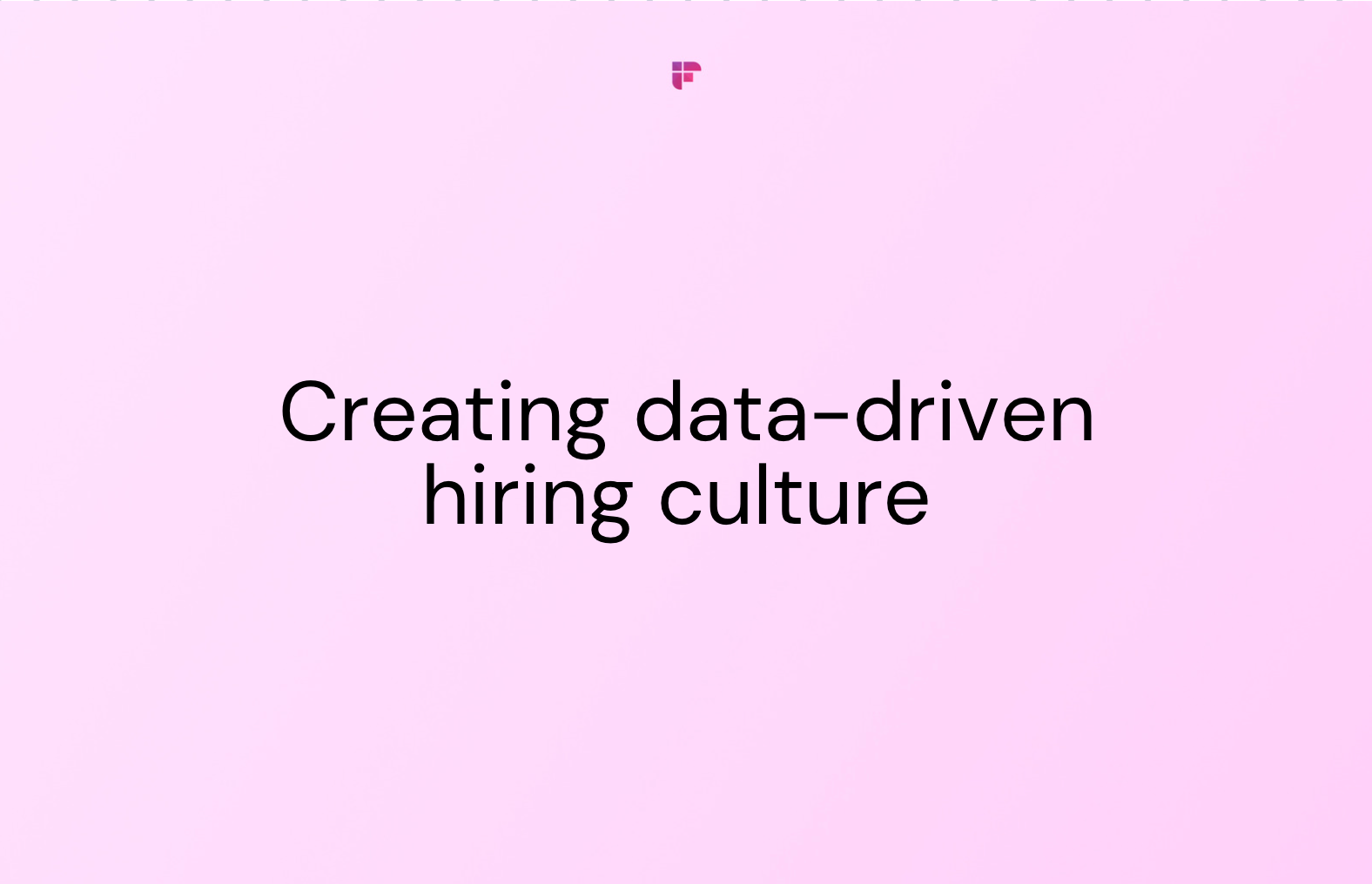Developing a top-tier hiring culture is just as essential for a business as its profits. Whether sorting applications or tracking engagements, every aspect contributes significantly to the bigger picture.
The cornerstone of a thriving brand culture is the hiring process. It eventually drives the wheel of brand building, so it requires much of your input, especially in development. Below is a short introduction to the hiring culture and five effective ways to build a data-driven hiring culture.
Understanding the hiring culture

Fundamentally, the hiring process marks the beginning of cultural development for any business. It's the point where you take people on board and begin developing a team. The recruitment team needs to first assess a company's needs, post relevant job descriptions, and find potential candidate matches. Doing so will communicate your brand's persona with maximum possible clarity.
We also suggest you appoint employees at the interview sessions who better understand the brand's growth rate, vision, and mission. Representatives with a better grasp deliver a better idea and reduce unnecessary hassle created by miscommunication.
Data culture: what is it?
In simplest terms, a data-driven culture refers to an organizational environment where data is readily available, valued, and consistently used to drive decision-making processes.
In organizations with a data-driven decision-making culture, data literacy— the ability to read, comprehend, produce, and communicate data—is pervasive. That means data isn't confined to a group of data scientists or a specific department. Instead, it permeates the entire organization and influences decision-making at all levels. McKinsey & Company's recent research reveals that data-driven organizations can achieve up to a 25% improvement in EBITDA.
5 Ways of building data-driven culture
Today, data-driven hiring trends have largely replaced traditional hiring methods. Such a process uses statistics and data information to direct all hiring plans and decisions.
The calculated approach helps in increasing the productivity and efficiency of a company. It reduces the hiring time cycle and generally throws up better candidate choices. The data-driven process improves the candidates' journey too. So, this effective strategy is a win-win situation for both sides. The following are a few ways to build a data-driven culture:
1. Integrate Fireflies into your recruitment process

Artificial intelligence (AI) has entered every industry, and recruitment is no exception. So, consider integrating AI into your data-driven recruitment strategies.
An AI-powered tool, Fireflies, can significantly help your business build a data-driven hiring culture. This tool captures voice meeting notes and transcribes, summarizes, and analyzes them.
Integrating it into your hiring strategies will allow you to record and transcribe virtual meeting interviews. Your company's hiring managers and recruiters can use this transcription to review candidates' responses in detail after the interview.
Fireflies can also analyze candidates' offline responses. This can help you identify critical skills, traits, and competencies exhibited by candidates. Thus, you will be able to make an informed hiring decision.
Other features that make Fireflies worthy of integration into your recruitment strategies are:
- Conversation Intelligence will allow you to uncover desired traits and skills in candidates and spot red flags. You can easily access insights such as total time spent in conversations, sentiments—positive, negative, or neutral—in conversations, and the number of questions asked.
- Transcribes captured meetings in more than 60 languages, including German, French, Arabic, and Portuguese. This is especially beneficial for a global team, as it allows members from diverse countries to overcome language barriers and communicate clearly.
- Topic Tracker will allow you to search for topics across transcription by entering relevant keywords. You can, for instance, analyze discussions around compensation and benefits by simply using keywords like "pay," "salary," or "benefits."
- Streamline your recruiting operations by organizing all your interviews in Channels. Create separate channels for different stages of the hiring process, such as initial screenings, technical assessments, and many more.
- Smart Search filters will allow you to search the critical parts of the interview from meeting transcripts and listen to them instead of the whole meeting.
- Integrates with applicant tracking systems through Fireflies API and eliminates manual data entry by logging notes, calls, and transcripts into them.
- Create short audio clips from recorded interviews of star interviewers and share them with your new interviewers through the Soundbites feature. This will help as training goldmine and help them understand how to build rapport, dig deeper into their potential, and close candidates.
- Make playlists of Soundbites of the best interviews by roles like Sales Reps, Project Manager, and more so that new recruiters can observe entire interviews with the best candidates—from screening to closing.
Check out how you can use Fireflies to transcribe job interviews in this easy-to-read guide.
💡 Streamline Your Recruitment Process by Integrating Fireflies into Your Hiring Process
Fireflies simplifies note-taking by automatically capturing voice conversations. It also transcribes, summarizes, and analyzes them, making your meetings more productive.
2. Know where you're going
Since data-driven hiring plans are entirely based on facts and figures, you need a clear direction to maximize your collected data. Some companies focus on engagement insights with candidates and applicant demographics, while others wish to assess the quality of the hiring process. For the latter, the relevant metrics to track include time to hire, source of hire, rate of job acceptance, etc.
Before collecting either data, you need to have a goal in mind. So, you and your team can work towards that specific goal and maximize the efficiency of the data-driven hiring culture.
3. Pick the right tech and tools
In data collection, the technical tools involved or used are equally important. Hence, choose which technology will best suit you to yield the maximum results. You can use applicant tracking software (ATS) to your advantage. And collect data via inline surveying platforms, such as Google Analytics.
After collecting the data, also give ample time to determine its best use. For example, data collected for time-to-hire can help you determine whether you're going higher than the industry average or lower. If it's higher, you can figure out the possible reasons and fix those weaker aspects for a better output.
4. Keep everyone included
The final hiring decision might lie with the highest executives. However, the process's execution depends on the entire team. For a successful hiring process and execution, the involved parties must acknowledge that it is a team effort.
Mutual collaboration and communication among team members and the hierarchical authorities builds confidence, streamlines the hiring process, and leads to better outcomes. Also, increased involvement trains most employees for interview sessions.
5. Encourage professional growth

Lastly, one of the most effective ways to build a data-driven culture for 2024 is to encourage professional growth.
Well, training! Keep encouraging your team to participate in workshops relevant to their field to upgrade their skills and overall performance. As a leader, you can even create professional development opportunities such as seminars and short courses to help keep up with the latest advancements in tech or approaches.
Also, to encourage professional growth, provide your team with all the latest equipment. It can be computer accessories, new software, or anything similar.
Wrapping it up
In the age of digital transformation, data has emerged as a vital resource for businesses. That is why it has become imperative for organizations seeking to make informed recruitment decisions to build a data-driven hiring culture.
Bear in mind that fostering a data-driven culture isn't a one-off initiative. Instead, it is an ongoing process that requires strategic planning, dedication, and effort. The benefits—innovation, effective decision-making, and increased employee retention—make it worthwhile. As we move into a data-driven age, organizations that successfully build a solid data culture will be better able to use data for long-term success.







